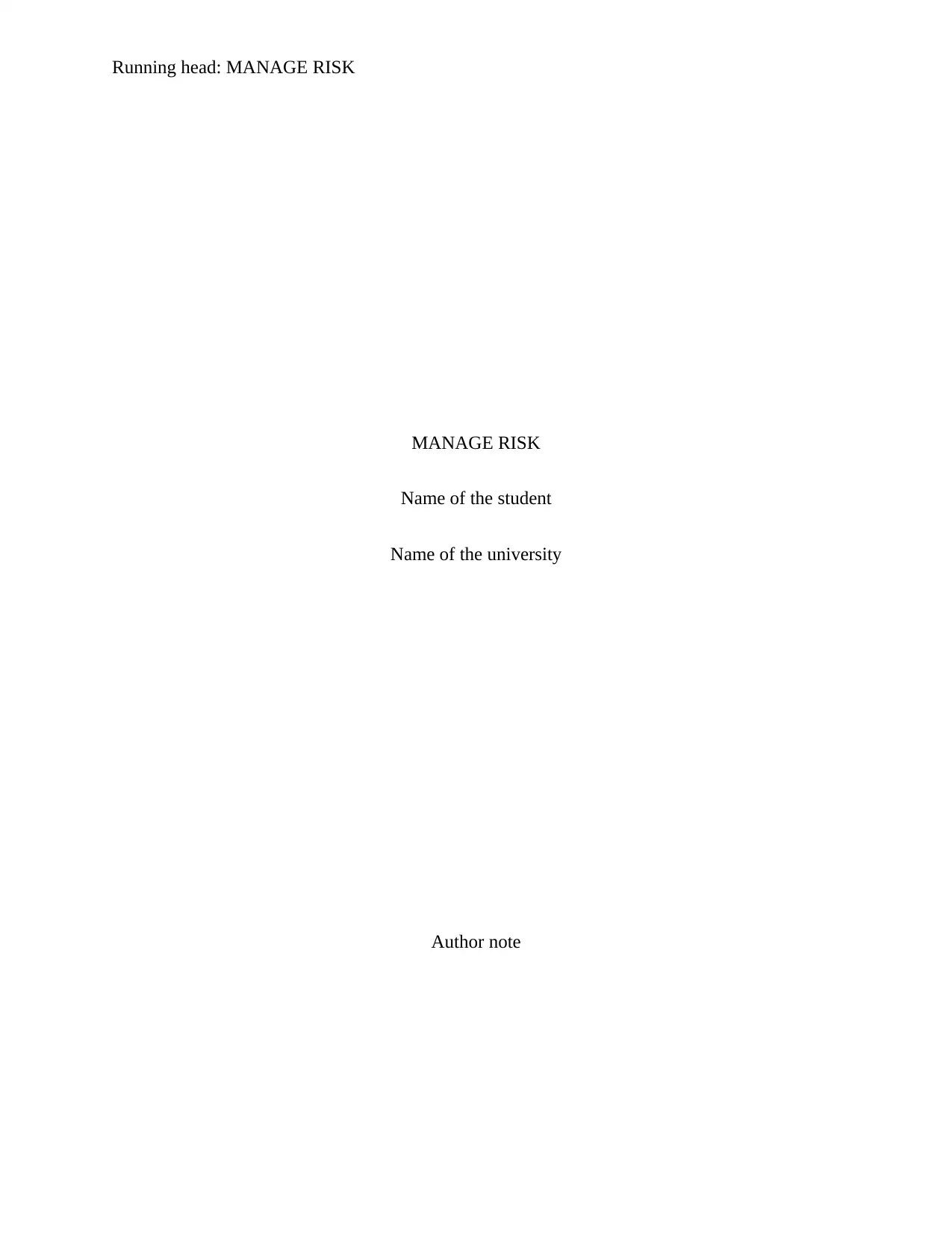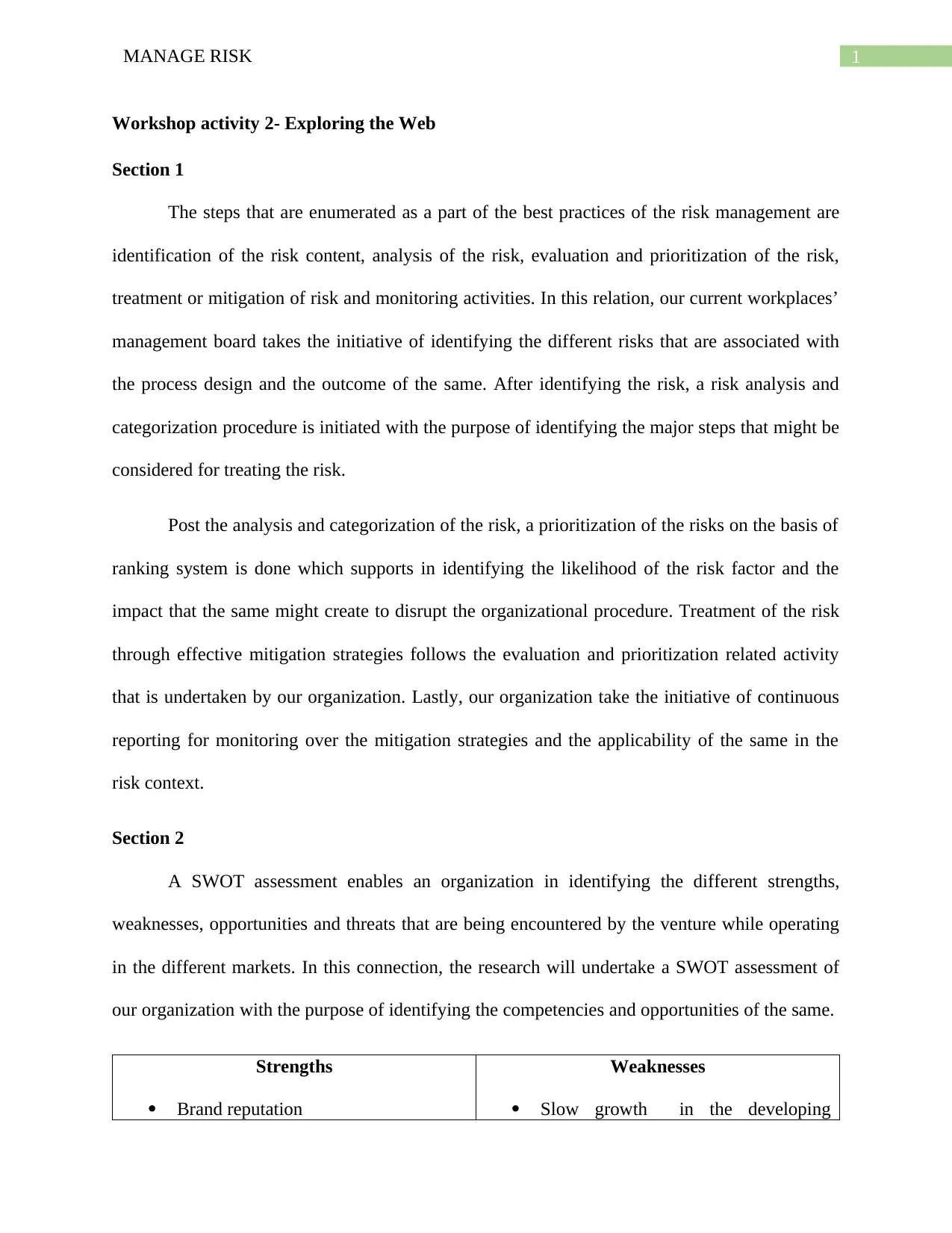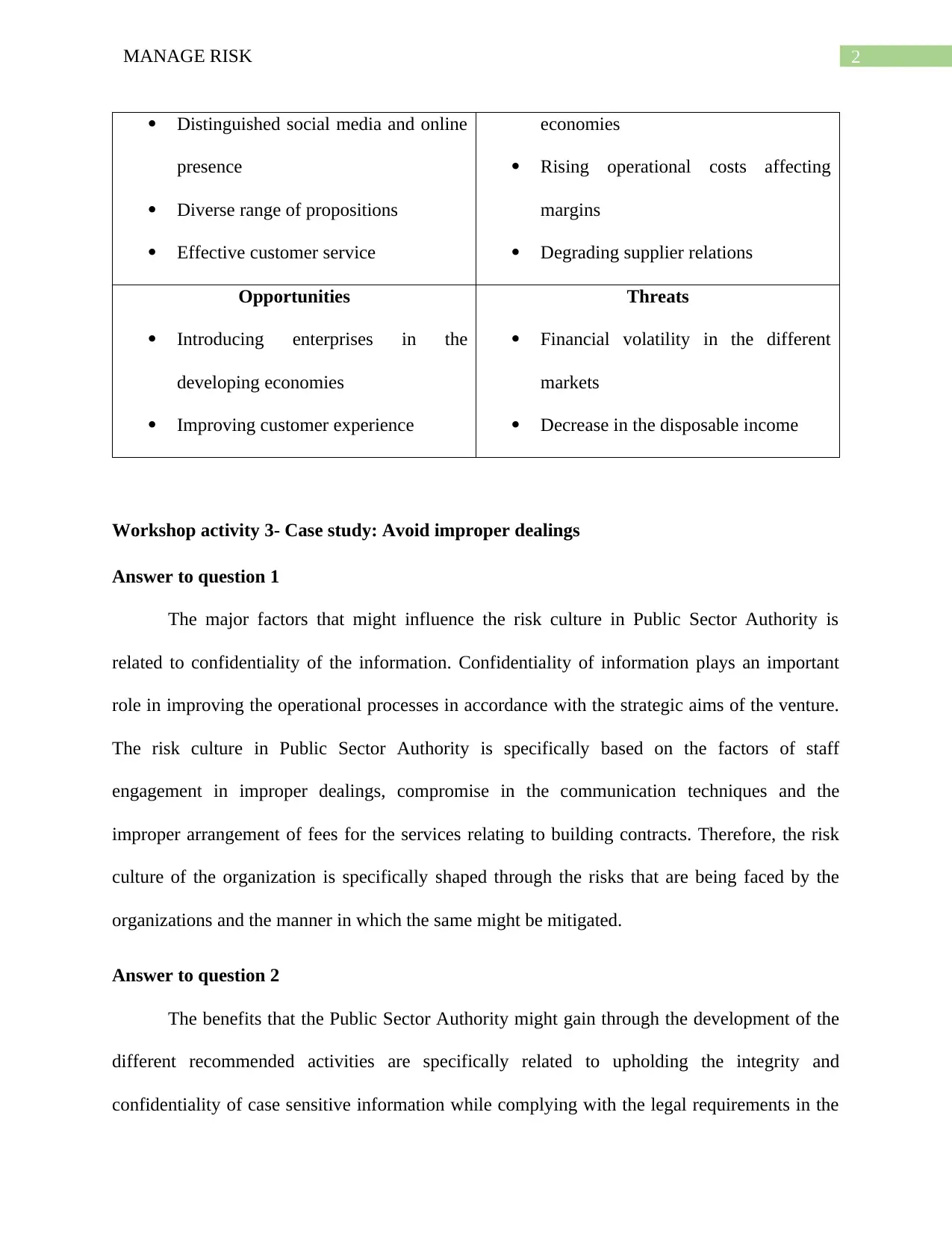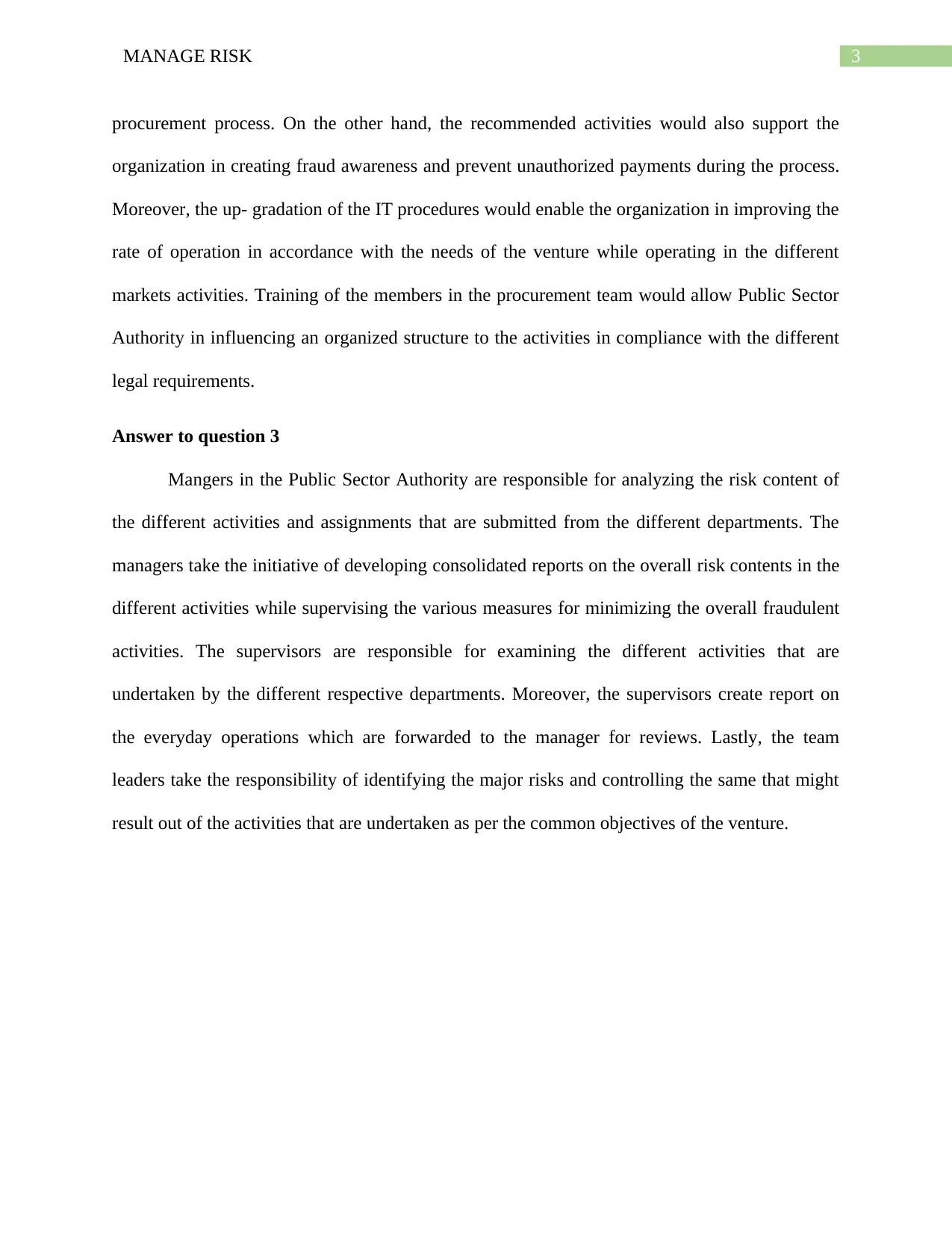Risk Management Report: Exploring Risk and Case Study Analysis
VerifiedAdded on 2022/08/16
|4
|740
|12
Report
AI Summary
This report delves into risk management, beginning with an overview of best practices, including risk identification, analysis, evaluation, mitigation, and monitoring. It then presents a SWOT analysis of an organization, outlining its strengths, weaknesses, opportunities, and threats. Furthermore, the report analyzes a case study focused on the Public Sector Authority, addressing factors influencing risk culture, the benefits of recommended activities, and the responsibilities of managers, supervisors, and team leaders in managing risk. The report explores the importance of confidentiality, fraud awareness, and the role of IT procedures and training in mitigating risks within the organization. The report examines the potential for fraud and the steps required to address it.

Running head: MANAGE RISK
MANAGE RISK
Name of the student
Name of the university
Author note
MANAGE RISK
Name of the student
Name of the university
Author note
Paraphrase This Document
Need a fresh take? Get an instant paraphrase of this document with our AI Paraphraser

1MANAGE RISK
Workshop activity 2- Exploring the Web
Section 1
The steps that are enumerated as a part of the best practices of the risk management are
identification of the risk content, analysis of the risk, evaluation and prioritization of the risk,
treatment or mitigation of risk and monitoring activities. In this relation, our current workplaces’
management board takes the initiative of identifying the different risks that are associated with
the process design and the outcome of the same. After identifying the risk, a risk analysis and
categorization procedure is initiated with the purpose of identifying the major steps that might be
considered for treating the risk.
Post the analysis and categorization of the risk, a prioritization of the risks on the basis of
ranking system is done which supports in identifying the likelihood of the risk factor and the
impact that the same might create to disrupt the organizational procedure. Treatment of the risk
through effective mitigation strategies follows the evaluation and prioritization related activity
that is undertaken by our organization. Lastly, our organization take the initiative of continuous
reporting for monitoring over the mitigation strategies and the applicability of the same in the
risk context.
Section 2
A SWOT assessment enables an organization in identifying the different strengths,
weaknesses, opportunities and threats that are being encountered by the venture while operating
in the different markets. In this connection, the research will undertake a SWOT assessment of
our organization with the purpose of identifying the competencies and opportunities of the same.
Strengths
Brand reputation
Weaknesses
Slow growth in the developing
Workshop activity 2- Exploring the Web
Section 1
The steps that are enumerated as a part of the best practices of the risk management are
identification of the risk content, analysis of the risk, evaluation and prioritization of the risk,
treatment or mitigation of risk and monitoring activities. In this relation, our current workplaces’
management board takes the initiative of identifying the different risks that are associated with
the process design and the outcome of the same. After identifying the risk, a risk analysis and
categorization procedure is initiated with the purpose of identifying the major steps that might be
considered for treating the risk.
Post the analysis and categorization of the risk, a prioritization of the risks on the basis of
ranking system is done which supports in identifying the likelihood of the risk factor and the
impact that the same might create to disrupt the organizational procedure. Treatment of the risk
through effective mitigation strategies follows the evaluation and prioritization related activity
that is undertaken by our organization. Lastly, our organization take the initiative of continuous
reporting for monitoring over the mitigation strategies and the applicability of the same in the
risk context.
Section 2
A SWOT assessment enables an organization in identifying the different strengths,
weaknesses, opportunities and threats that are being encountered by the venture while operating
in the different markets. In this connection, the research will undertake a SWOT assessment of
our organization with the purpose of identifying the competencies and opportunities of the same.
Strengths
Brand reputation
Weaknesses
Slow growth in the developing

2MANAGE RISK
Distinguished social media and online
presence
Diverse range of propositions
Effective customer service
economies
Rising operational costs affecting
margins
Degrading supplier relations
Opportunities
Introducing enterprises in the
developing economies
Improving customer experience
Threats
Financial volatility in the different
markets
Decrease in the disposable income
Workshop activity 3- Case study: Avoid improper dealings
Answer to question 1
The major factors that might influence the risk culture in Public Sector Authority is
related to confidentiality of the information. Confidentiality of information plays an important
role in improving the operational processes in accordance with the strategic aims of the venture.
The risk culture in Public Sector Authority is specifically based on the factors of staff
engagement in improper dealings, compromise in the communication techniques and the
improper arrangement of fees for the services relating to building contracts. Therefore, the risk
culture of the organization is specifically shaped through the risks that are being faced by the
organizations and the manner in which the same might be mitigated.
Answer to question 2
The benefits that the Public Sector Authority might gain through the development of the
different recommended activities are specifically related to upholding the integrity and
confidentiality of case sensitive information while complying with the legal requirements in the
Distinguished social media and online
presence
Diverse range of propositions
Effective customer service
economies
Rising operational costs affecting
margins
Degrading supplier relations
Opportunities
Introducing enterprises in the
developing economies
Improving customer experience
Threats
Financial volatility in the different
markets
Decrease in the disposable income
Workshop activity 3- Case study: Avoid improper dealings
Answer to question 1
The major factors that might influence the risk culture in Public Sector Authority is
related to confidentiality of the information. Confidentiality of information plays an important
role in improving the operational processes in accordance with the strategic aims of the venture.
The risk culture in Public Sector Authority is specifically based on the factors of staff
engagement in improper dealings, compromise in the communication techniques and the
improper arrangement of fees for the services relating to building contracts. Therefore, the risk
culture of the organization is specifically shaped through the risks that are being faced by the
organizations and the manner in which the same might be mitigated.
Answer to question 2
The benefits that the Public Sector Authority might gain through the development of the
different recommended activities are specifically related to upholding the integrity and
confidentiality of case sensitive information while complying with the legal requirements in the
⊘ This is a preview!⊘
Do you want full access?
Subscribe today to unlock all pages.

Trusted by 1+ million students worldwide

3MANAGE RISK
procurement process. On the other hand, the recommended activities would also support the
organization in creating fraud awareness and prevent unauthorized payments during the process.
Moreover, the up- gradation of the IT procedures would enable the organization in improving the
rate of operation in accordance with the needs of the venture while operating in the different
markets activities. Training of the members in the procurement team would allow Public Sector
Authority in influencing an organized structure to the activities in compliance with the different
legal requirements.
Answer to question 3
Mangers in the Public Sector Authority are responsible for analyzing the risk content of
the different activities and assignments that are submitted from the different departments. The
managers take the initiative of developing consolidated reports on the overall risk contents in the
different activities while supervising the various measures for minimizing the overall fraudulent
activities. The supervisors are responsible for examining the different activities that are
undertaken by the different respective departments. Moreover, the supervisors create report on
the everyday operations which are forwarded to the manager for reviews. Lastly, the team
leaders take the responsibility of identifying the major risks and controlling the same that might
result out of the activities that are undertaken as per the common objectives of the venture.
procurement process. On the other hand, the recommended activities would also support the
organization in creating fraud awareness and prevent unauthorized payments during the process.
Moreover, the up- gradation of the IT procedures would enable the organization in improving the
rate of operation in accordance with the needs of the venture while operating in the different
markets activities. Training of the members in the procurement team would allow Public Sector
Authority in influencing an organized structure to the activities in compliance with the different
legal requirements.
Answer to question 3
Mangers in the Public Sector Authority are responsible for analyzing the risk content of
the different activities and assignments that are submitted from the different departments. The
managers take the initiative of developing consolidated reports on the overall risk contents in the
different activities while supervising the various measures for minimizing the overall fraudulent
activities. The supervisors are responsible for examining the different activities that are
undertaken by the different respective departments. Moreover, the supervisors create report on
the everyday operations which are forwarded to the manager for reviews. Lastly, the team
leaders take the responsibility of identifying the major risks and controlling the same that might
result out of the activities that are undertaken as per the common objectives of the venture.
1 out of 4
Related Documents
Your All-in-One AI-Powered Toolkit for Academic Success.
+13062052269
info@desklib.com
Available 24*7 on WhatsApp / Email
![[object Object]](/_next/static/media/star-bottom.7253800d.svg)
Unlock your academic potential
Copyright © 2020–2025 A2Z Services. All Rights Reserved. Developed and managed by ZUCOL.





